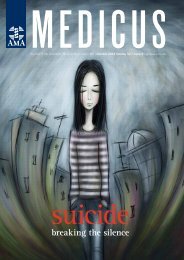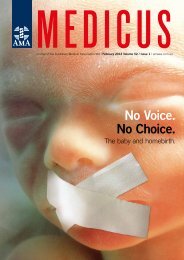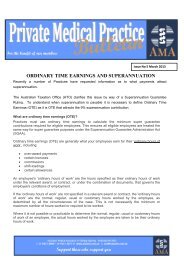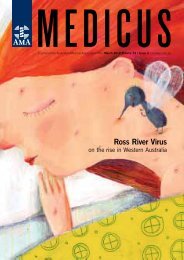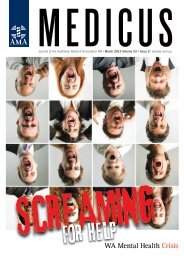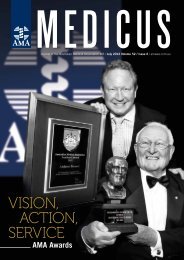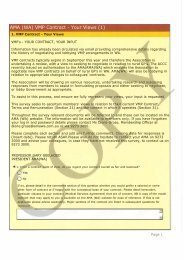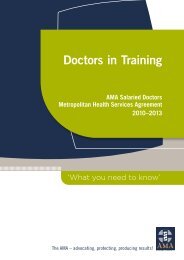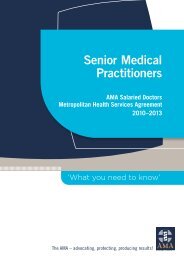twrama 1841_august_2.. - AMA WA
twrama 1841_august_2.. - AMA WA
twrama 1841_august_2.. - AMA WA
Create successful ePaper yourself
Turn your PDF publications into a flip-book with our unique Google optimized e-Paper software.
OPINION<br />
Kids’ stuff<br />
by Associate Professor Frank R Jones<br />
Chair, RACGP <strong>WA</strong> Faculty and <strong>AMA</strong> (<strong>WA</strong>) Councillor<br />
It is true as one grows older as a GP, one’s patient following<br />
also seem to inextricably age. These days I see older patients<br />
with complex co-morbidities, polypharmacy issues and an<br />
increased expectation of survival associated with a good<br />
quality of life.<br />
Most of us struggle with the ageing process and the<br />
prospect of loss of independence, and statistics bear this out.<br />
As the demographics of the Australian population age, so does<br />
the average age of the patient encountered in general practice.<br />
The population of adults and seniors is rising at a faster rate<br />
than the population of children.<br />
What a medical pleasure it is then when I get to see a toddler<br />
with a “simple” upper respiratory tract infection (URTI) or<br />
cough. Or is it so simple?<br />
Is this child really ill? How do I know? How do I teach<br />
my registrar when it is okay to practice “watchful waiting”?<br />
Does my registrar think “why here, why now”? In fact, is my<br />
registrar seeing enough paediatric cases to be confident and be<br />
deemed competent? Am I seeing enough cases to be as assured<br />
as I was after my Diploma in Child Health training?<br />
What about more “complex” paediatrics – developmental<br />
issues and behavioural problems? What about an<br />
understanding of the close interaction between the child’s<br />
social environment and illness?<br />
Our younger Aboriginal and Torres Strait Islander<br />
populations have really complex unmet needs – morbidity<br />
statistics speak for themselves. And then, how do we access<br />
appropriate services for<br />
these very vulnerable<br />
A recent paper...suggested<br />
patients? We all<br />
that exposure of general<br />
know how difficult practice registrars to<br />
co-ordination<br />
chronic illness in children,<br />
of care is for the<br />
and to a range of other<br />
parents of a child<br />
more acute diagnostic<br />
with mixed physical<br />
conditions, may be<br />
and intellectual issues.<br />
General practitioners increasingly limited<br />
have a critical role in<br />
advocacy here – know<br />
your local referral pathways and<br />
be a champion for your young patient.<br />
A recent paper in the Australian Family Physician caught<br />
my eye (Vol. 41, No. 7, July 2012). In essence, the paper<br />
suggested that exposure of general practice registrars to<br />
chronic illness in children, and to a range of other more acute<br />
diagnostic conditions, may be increasingly limited. Somewhat<br />
surprisingly, registrars spent most of their time in consultations<br />
with patients aged 65 plus years and the least time with children<br />
aged 5–14 years. Only one in 10 consults were with children less<br />
than four years of age. Long consultations were virtually absent.<br />
These figures are of concern.<br />
How can we ensure our young doctors have adequate<br />
exposure and experience on the one hand to recognise and<br />
manage the acute sick child, and on the other, have the ability<br />
32 MEDICUS August




